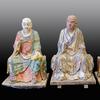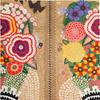Toronto Biennial of Art announces preliminary list of artists, partners, and sponsors for 2021 edition
- TORONTO, Canada
- /
- October 20, 2020
The Toronto Biennial of Art (the Biennial) today announced an initial selection of Canadian and international artists for the second edition of the city-wide event on view September 25 through December 5, 2021. Commissioned and invited participants contributing to exhibitions, programs, and residencies include Nadia Belerique, Judy Chicago, Sebastian De Line, Jorge González, Lawrence Abu Hamdan, Brian Jungen, Waqas Khan, Vanessa Kwan, Ange Loft, Mata Aho Collective, Eric-Paul Riege, Camille Turner, and Syrus Marcus Ware. The curatorial team, Tairone Bastien, Clare Butcher, Candice Hopkins, Myung-Sun Kim, and Katie Lawson are coming together to work collectively across projects. Additional contributors, partners, and sponsors will be announced in the coming months.
The Biennial commissions will take place in diverse venues throughout the city, moving beyond the Lake Ontario shoreline locations that hosted the 2019 edition. The 2021 Biennial will explore locations near above-ground and hidden water tributaries that feed into the Lake as well as the ravines that shape Toronto. Extending the interconnections of those locations and expanding the notions of what it means “being in relation” that was the central question of the inaugural Biennial, continues to be a guiding principle in a moment of great uncertainty.
In this second chapter of the Biennial, the curators envision new forms of kinship—with each other, their collaborators, ideas, perspectives, and with the inanimate. They have generated a lexicon—a shared vocabulary—to ground their thinking and ongoing processes of exhibition-making, programming, engaging, learning, and unlearning. The first set of terms from this lexicon include kinship, collectivity, and belief, which the curators describe as a means by which “people relate to the unseen world. Belief is how we grasp or make sense of the unknowable. It is also around certain beliefs that people congregate to create myths, stories, and ceremonies. As old systems of belief collapse, we see possibilities for escape and renewal.” The developing lexicon and lines of inquiry will be shared on the Biennial website in the coming weeks – sign up for the newsletter for more updates.
Toronto Biennial of Art Founder and Executive Director Patrizia Libralato said, “We are delighted to share the curatorial team’s first thoughts around the 2021 Biennial’s thematic direction, as well as our exciting initial lineup of participating artists. Realizing our vision together through these challenging times of pandemic, political upheaval, and climate crisis, when existing belief systems are being tested and challenged, provides opportunities for reflection and change. We look forward to working with the artists as they create site-specific works and performance commissions that respond to the city’s complex cultural context and the pressing issues of our time. The Biennial team is also honored to welcome back partners and sponsors who continue to support our bold vision.”
2020 Residency Program
From November 2–15, 2020, the five Biennial curators will come together with commissioned participants in an experimental and research-focused virtual residency based on the framework of a pod system in transformative social justice practices. Within an ethos of community care and justice, the residency will be facilitated by Ange Loft and Syrus Marcus Ware to think and move together in exploring protocols and practices of connectivity in this moment. Further details of the residency program will be shared via the Biennial newsletter, website, and social media streams in the coming weeks.
Participants will include artists and curators Sebastian de Line, Jorge González, Vanessa Kwan, Mata Aho Collective, Eric-Paul Riege, Camille Turner, (see brief bios below), and others, and will be facilitated by Loft and Ware with the Toronto Biennial of Art curators. Supporting partners include Black Lives Matter – Toronto and grunt gallery.
Preliminary List of 2021 Biennial Participants
Nadia Belerique (b. in Toronto, ON, Canada; lives in Toronto, ON, Canada) intentionally disrupts the way we look at images. She often alters conventional photographic perspectives or re-photographs prints in her studio to create multi-layered images that conflate places and moments. For the 2021 Biennial, Belerique will present an installation that considers the movement of goods tethering people and places across oceans and land. Alternating between transparency and opacity, industrial and domestic, Belerique’s materials speak of relations maintained and troubled by distance and desire, memory and forgetting.
Judy Chicago (b. in Chicago, IL, US; lives in Belen, NM, US) is an artist, author, feminist, educator, and intellectual whose career spans five decades. Her far-reaching influence both within and beyond the art community is attested to by her inclusion in hundreds of publications and collections throughout the world. Chicago turned to pyrotechnics in the late 1960s in an effort to feminize the atmosphere of the hyper-masculine Land Art movement. Her “atmospheres” initially took place in cracks and fissures in the land, the whirling plumes of brilliantly coloured smoke softening the landscape and eventually disappearing altogether. In 2021, Chicago will produce a new “atmosphere” for Toronto’s shoreline.
Sebastian De Line (b. in Burnaby, BC, Canada; lives on Haudenosaunee and Anishinaabe territory in Ka’tarohkwi, Kingston, ON, Canada) is a queer, trans artist, scholar, and lecturer of Haudenosaunee-Métis-Cantonese descent. He/they are a curatorial resident for the 2021 Biennial. His/their work investigates the manufacturing of economies that instill ancestors (in Eurocentric terms called artifacts or objects) into museum collections produced by systems of colonial property production generating value through necropolitical capitalization upon states of unliving.
Jorge González’s (b. in Borikén, Puerto Rico; lives in Borikén, Puerto Rico, US) artistic practice serves as a platform for the recuperation of Boricua material culture, in an attempt to create new narratives between the indigenous and the modern. In 2014, he founded Escuela de Oficios in response to omissions of dominant histories and deteriorating academic spaces. Proposing recovery through community regeneration, Escuela de Oficios creates spaces for collective learning and promotes self-directed education. Its activities include mapping, documenting and employing artisanal techniques, and creating a mobile program that includes conversations, workshops, and exhibitions.
Lawrence Abu Hamdan (b. in Amman Jordan; lives in Beirut, Lebanon) is interested in sound and its intersection with politics originating from his background as a touring musician and facilitator of DIY music. The artist’s audio investigations have been used as evidence at the UK Asylum and Immigration Tribunal and as advocacy for organizations such as Amnesty International and Defense for Children International together with fellow researchers from Forensic Architecture.
For the 2021 Biennial, Abu Hamdan will explore the legal terms of immigration processes writ large across spaces between nation-state borders. Co-commissioned by the Biennial and presented in collaboration with Mercer Union, Abu Hamdan will present a body of work that draws on recent border disputes in the US, and the divisive impact of Executive Order 13769 (a.k.a. the Muslim ban), deciphering the symbolic and legal potential of these interstitial and fugitive spaces.
Brian Jungen (Dane-zaa /Swiss, b. in Fort St. John, BC, Canada; lives near Vernon, BC, Canada) is noted for repurposing commercial consumer goods, configuring them into intricate sculptures that resemble traditional Indigenous art or natural forms. A member of the Doig River band of the Dane-zaa First Nation, Jungen’s work references his European-Dane-zaa ancestry, while critiquing labour practices, the relationships between humans and nature, and the effects of global capitalism on First Nations communities and their culture and how the products of global capitalism are repurposed in Native communities.
Waqas Khan (b. in Akhtarabad, Pakistan; lives in Lahore, Pakistan) creates large-scale minimalist drawings that resemble webs and celestial expanses. Khan employs small dashes and minuscule dots to create large entanglements. Khan’s work also evokes a sense of scripting, which he likes to see as a discourse between himself and his viewer.
Vanessa Kwan (b. in St.John’s NF, Canada; lives in Vancouver, BC, Canada) is an artist and curator with a focus on collaborative, site-specific, and community-engaged practices. Her public commissions include a geyser (Geyser for Hillcrest Park, 2012, with Erica Stocking), a garden best viewed by moonlight (This creeping root, 2016) and a permanent sound installation exploring urban narratives of restlessness and care (Speaker A, with Theatre Replacement, 2020). As program director at grunt gallery, she manages residencies, exhibitions, and special projects and is also curator/ producer at Other Sights for Artists’ Projects, an artist-run organization that curates and produces artworks for the public realm.
Ange Loft (Kahnawake Mohawk, b. in Kahnawake, QC, Canada; lives in Toronto, ON, Canada) is associate artistic director of Jumblies Theatre and an interdisciplinary performing artist and initiator. She facilitates interdisciplinary creation, arts based research, oral history, outdoor performance, community art design, and wearable sculpture. In 2019, the Biennial commissioned Ange Loft to author the Toronto Indigenous Context Brief. The document initially drafted for organizers and for artists, it disrupted the belief in settled narratives, shifting the layers of official and unofficial histories to add new ones. This document has inspired a new book, the aptly named Treaty Guide for Torontonians, to be published in 2021, that extends relationality from the social to the judicial.
Mata Aho Collective (established in 2012; based in Aotearoa New Zealand) is a collaboration between four Māori women who produce large scale fiber based works, commenting on the complexity of Māori lives. Their conceptual framework is founded within the contemporary realities of mātauranga Māori (Indigenous knowledge systems) and they produce works as a single collective authorship that is bigger than their individual capabilities. The collective includes Erena Baker (Te Atiawa ki Whakarongotai, Ngāti Toa Rangātira); Sarah Hudson (Ngāti Awa, Ngāi Tūhoe); Bridget Reweti (Ngāti Ranginui, Ngāi Te Rangi), and Terri Te Tau (Rangitāne ki Wairarapa.)
Eric-Paul Riege (Diné, b. in Na’nízhoozhí, Gallup, NM, US; lives in Gallup, NM, US) is a weaver and fiber artist who creates woven sculptures, wearable art, and durational performances that, to him, directly link him to generations of makers and women weavers in his family. According to the artist, the pieces are informed by Hózhó, a Diné philosophy and a way of being that “encompasses beauty, balance, and goodness in all things physical and spiritual and its bearing on everyday experience.”
Camille Turner (b. in Kingston, Jamaica; lives in Los Angeles, CA, US and Toronto, ON, Canada) is a Canadian media and performance artist, curator, and educator. The artist explores race, space, home, and belonging. Her interventions, installations, and public engagements combine Afrofuturism and historical research and have been presented throughout Canada and internationally.
Syrus Marcus Ware (b. in Montreal, QC, Canada; lives in Toronto, ON, Canada) is a Vanier Scholar, visual artist, activist, curator, and educator. Ware works in painting, installation, and performance to explore social justice frameworks and Black activist culture. His work often aims to challenge systemic oppression and explore the spaces between and around identity. He is part of the Performance Disability Art Collective and a core team member of Black Lives Matter – Toronto.
Preliminary List of Partners
Building creative partnerships through collaborative installations, exhibitions, and programming across Toronto is an integral part of the Biennial’s core activities. The 2021 Biennial will work with innovative art spaces, established art institutions, artist-run centers, community organizations, and educational institutions including aabaakwad; Aga Khan Museum; Art Toronto; ArtworxTO: Toronto’s Year of Public Art 2021; Black Lives Matter - Toronto; Evergreen; Fogo Island Arts; grunt gallery; Mercer Union; Momenta; MOCA Toronto; OCAD University; Ryerson Image Centre; Small Arms Inspection Building; The Bentway; The Power Plant Contemporary Art Gallery; Toronto Sculpture Garden and Toronto Union. Additional partners and venues will be announced in the coming months.
Preliminary List of Sponsors and Supporters
The Biennial is pleased to announce that the 2021 edition is generously supported by Canada Council for the Arts; Canadian Art; Castlepoint Numa; City of Mississauga; City of Toronto; Dickinson Wright; St. Joseph Communications;Toronto Arts Council; and Woodbridge Limited. More sponsors will be announced in the coming months. The Biennial recognizes the renewed and significant private donations of Michelle Koerner and Kevin Doyle, The Michael & Sonja Koerner Charitable Foundation, and The Pierre Lassonde Family Foundation. The Biennial also recognizes the ongoing and generous support of the Biennial’s Founding Visionaries, Contemporaries, and Patrons.
About the Toronto Biennial of Art
The Toronto Biennial of Art’s mission is to make contemporary art available to everyone. For 10 weeks every two years, local and international Biennial artists transform the city and surrounding regions with artworks, talks, and performances that reflect local contexts and pressing issues of our time. The Biennial’s free, citywide programming aims to inspire people, bridge communities, and contribute to global conversations.
Five years in the planning, the inaugural Toronto Biennial of Art launched in 2019, was a popular and critical success. The Biennial welcomed nearly 300,000 local and international visitors to 15 sites, featuring 161 artists and performers. The Biennial provided expanded views of contemporary art practice, including significant contributions by BIPOC artists and artworks, and established a legacy of free and accessible contemporary arts programming in Toronto, Mississauga, and the surrounding GTA.
For more information, visit: torontobiennial.org, @torontobiennial, and #TObiennial21 on Facebook, Twitter, and Instagram.
# # #
Contact:
Libby Mark or Heather MeltzerBow Bridge Communications
347-460-5566
info@bow-bridge.com










_-Closing-the-Distance_100x100_c.jpg)





